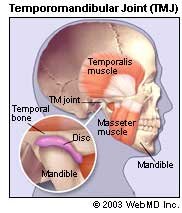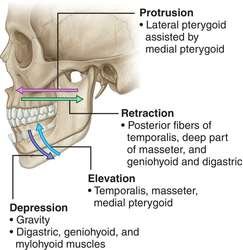- (239) 325-9410
- 5926 Premier Way. Suite 106. Naples. FL. 34109
TMD- What is it?
- Home
- TMD- What is it?
Shedding some light on a very common ailment: TMD
TMD is a far more common condition than people realize. You may have heard it on a dental advertisement, since it pertains to the jaw, but it has many more components beyond tooth ache or malocclusion. The TMJ (Temporomandibular joint) is composed of the muscles of mastication: temporalis, masseter, medial and lateral pterygoid; the temporal and mandible bone; articular disc; articular capsule; and the lateral, sphenomandibular and stylomandibular ligaments. This joint is a combined hinge and glide joint, which means the TMJ can depress, elevate, protract, retract, and deviate the mandible (jaw bone) right or left (unless there is something very wrong!). What’s unique about the TMJ is we only have one mandible, which has two TMJs. In fact the mandible is the only mobile bone of the skull and the only joint that when one TMJ moves, the other TMJ moves in a synchronous manner. This explains how TMD can have so many secondary problems and


Some of the common conditions of TMD are: muscle pain (myalgia), joint pain (arthralgia), headaches due to TMD, joint disorder (like joint displacement), and joint disease (like athrosis, osteoarthritis, and digenerative joint disease).
Researchers agree that TMD is a multifactorial condition, where many complex disorders tend to overlap and may take part in causing TMD. It has been said that 83% of TMD present with another type of chronic disorder such as back pain, neck and headaches. Widespread disorders such as fibromyalgia are also common with cases of TMD. Some connections have been made to TMD being caused by trauma and parafunction such as having our mouth open for extended periods such as for dental work or clenching and or grinding teeth over long periods of time. It is as well associated to psychosocial factors, such as stress or stressful events and depression.
So how is this complex condition treated? As you can assume we highly suggest manual therapy, along with self-care. Approximately 80% of TMD cases are caused my muscle pain, which will often involve trigger points with referral patterns to the teeth, ear, and eye. Stretching and repatterning proper musculoskeletal movement will aid in recovery and prevention of TMD. Using occlusal devices (like a mouth guard) may also help mediate the problem and prevent extended damage to the teeth.
If you have been suffering the sings and symptoms of TMD it is time to book in with a therapist and take control of this complicated disorder.
Sources
List, T et Hojland Jense, R. Temporomandubilar disorder: old ideas and new concepts. Cephalgia: an international journal of headaches. January 9 th , 2017
Medical-dictionary.thefreedictionary.com/temperomandibular+joint

Interested in receiving our monthly newsletter? Subscribe here!
